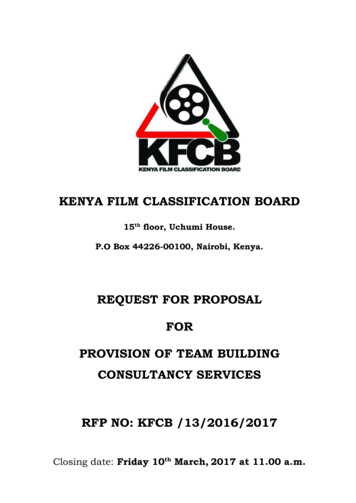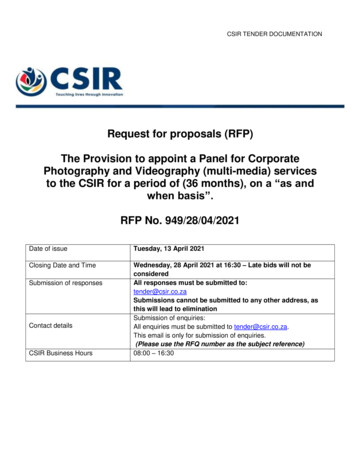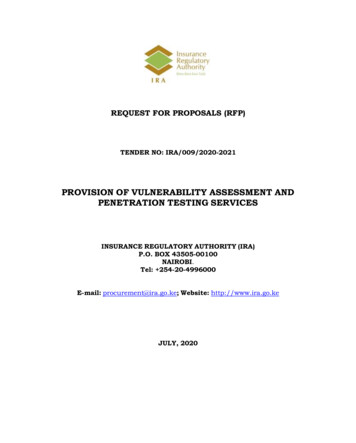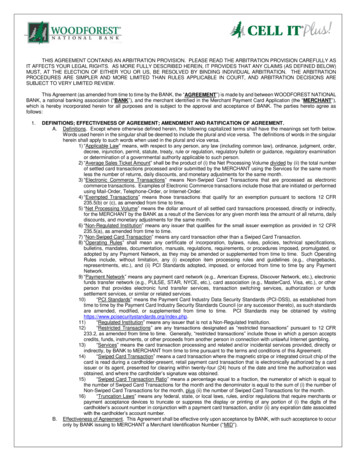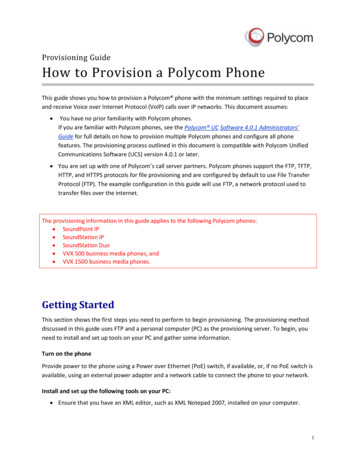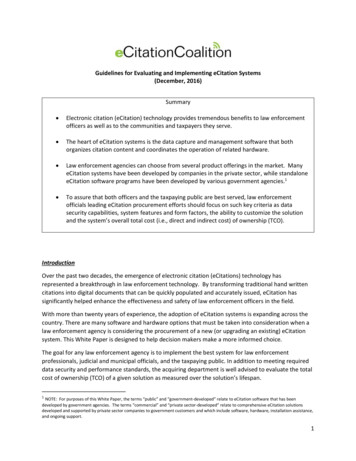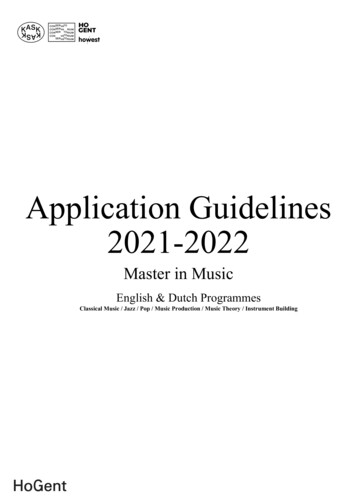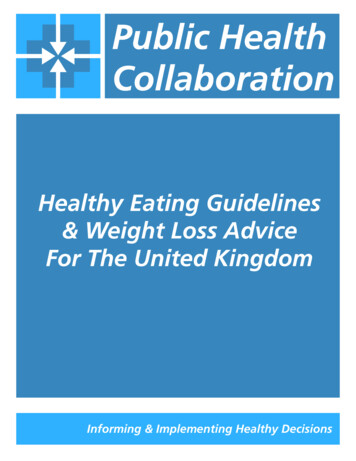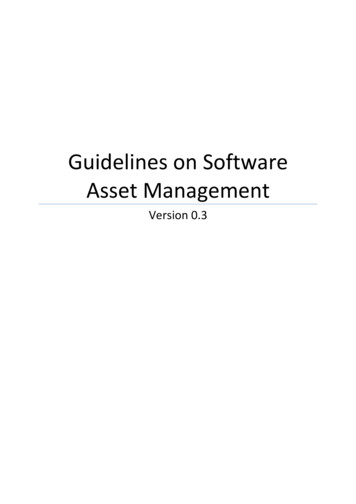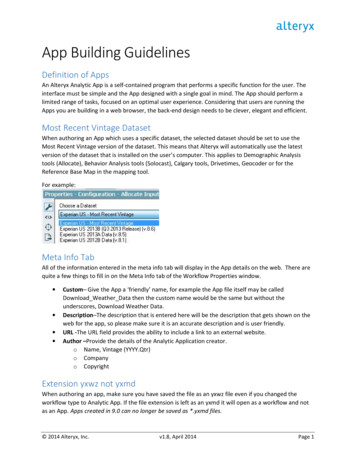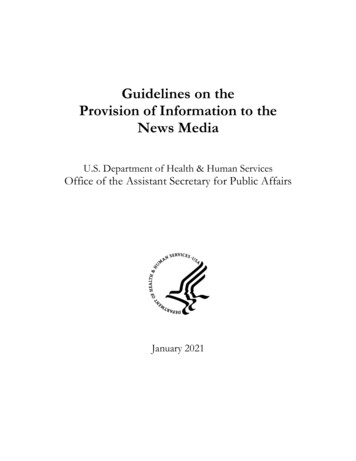
Transcription
Guidelines on theProvision of Information to theNews MediaU.S. Department of Health & Human ServicesOffice of the Assistant Secretary for Public AffairsJanuary 2021
Guidelines on the Release of Information to the News Media (January 2021)2BACKGROUNDThe Department of Health and Human Services (HHS) is the United States government's principalagency for protecting the health of all Americans and providing essential human services. HHS andits family of agencies manage more than 300 programs encompassing scientific research, publichealth services, food and drug safety, health care services, health insurance, and a host of childsupport and enrichment programs.HHS is committed to a culture of openness with the media and public that values the free exchangeof ideas, data, and information and doing so in a manner that is timely, responsive, and accurate. Tohonor this commitment, HHS expects its employees to abide by the following set of corecommunications principles: Be honest and accurate in all communicationsHonor publication embargoesRespond promptly to media requests and respect media deadlinesAct promptly to correct the record or erroneous information, when appropriatePromote the free flow of scientific and technical informationPromote plain writing of media documents and releasesCreate greatest transparency possible through distributing information timely and widelythrough internet, email, media wires, and other mechanismsProtect confidential, classified, and non-public informationPURPOSE AND SCOPEThis document provides guidance on the provision of information to news media. This is definedas information in any form provided to news and information media, especially information that hasthe potential to generate media attention, public interest, or inquiry.Examples include, but are not limited to, interviews, press releases, media advisories, editorial boards,letters to the editor, opinion-editorial columns, audio or video news releases, B-roll (video footageprovided free of charge to broadcast news organizations), and blogs and other Internet postingsused to convey news or items of public interest. Not included under this definition are scientific andtechnical reports or articles and technical information in professional journals.These guidelines are applicable to all Operating Divisions (OPDIV), Staff Divisions (STAFFDIV),Offices, and other programs (henceforth referred to as “agency”) within the Department of Healthand Human Services, as well as all HHS employees, fellows, and other non-full-time employeesemployed by HHS. In the event of any conflict between this guidance and any other HHS policy,directive, or regulation, this guidance shall govern and supersede any previous issuance or directive.Office of the Assistant Secretary for Public Affairs U.S. Department of Health and Human Services
Guidelines on the Release of Information to the News Media (January 2021)3RESPONSIBILITIESOffice of the Assistant Secretary for Public Affairs—News DivisionThe News Division of the HHS Office of the Assistant Secretary for Public Affairs (ASPA) is theprincipal point of contact, at the national level, for news media and general public inquiries aboutthe Department of Health and Human Services and its agencies.The News Division is responsible for: Conducting and coordinating news media relations for the department Establishing news media, including online news media, relations policies and priorities Coordinating and reviewing the performance of all news media relations activities Coordinating these activities with ASPA, HHS leadership, and OPDIVs and STAFFDIVs Clearing news media releases, activities, events, and materials Ensuring timely release and efficient dissemination of materials and information to newsmedia Editing to ensure that public information products are written in plain language, consistentwith Associated Press style, and in line with news media principles, practices, andexpectations, while maintaining the integrity of the scientific or technical data and themeaning of programmatic content.Directors of OPDIVs, STAFFDIVs, Offices and ProgramsOperating Division (OPDIV), Staff Division (STAFFDIV), office and program directors haveultimate responsibility for the technical, scientific, and programmatic accuracy of all information thatis related to their respective programs and released by HHS.OPDIV, STAFFDIV, Office and Program Communications/Public Affairs/Media RelationsOfficersThese individuals must notify the News Division, ASPA in a timely manner about activities orevents that have the potential to generate media or public interest or inquiry.All HHS Employees and ProgramsAll HHS employees and programs are required to coordinate, in a timely manner, with theappropriate agency media relations office prior to releasing information that has the potential togenerate media or public interest.GUIDELINESGeneral GuidelinesHHS seeks to provide the widest practical and appropriate dissemination of information concerningits activities, programs, and recommendations. News media and journalist requests, includingOffice of the Assistant Secretary for Public Affairs U.S. Department of Health and Human Services
Guidelines on the Release of Information to the News Media (January 2021)4blogger requests, for public information concerning HHS activities and the results of HHS activitiesshould be addressed promptly, factually, and as completely as possible, in accordance with applicablefederal laws and regulations.To ensure timely responses for requests for information, HHS will strive to ensure cooperation andcoordination among the agency’s scientific and public affairs communities. HHS agencies andoffices will comply with directives, procedures, and guidance from ASPA at HHS.In keeping with the desire for a culture of openness, HHS employees may, consistent with thispolicy, speak to members of the press about their work. However, HHS employees are not requiredto speak to the media.HHS strives to ensure that the media are effectively served within needed deadlines. In order tomake certain we provide the media the best possible service and information in a timely fashion, it isimportant that the relevant agency public affairs office be notified of all media calls/contacts thatemployees receive about their HHS work.Reporters should be informed that the agency’s public affairs office coordinates media requests toensure they receive requested information within their deadline The primary objective for routingreporter calls to the agency public affairs office is to ensure an effective, timely and coordinatedagency and departmental response.Additionally, depending on the context for the interview and the subject matter, the caller may bereferred to another HHS agency that has primary expertise in that area. In some instances, thecaller may need to be referred to another federal department or agency, if the matter lies within itsjurisdiction. Finally, in certain circumstances, the department must decline to comment. Theseinstances include, but are not limited to, pending legal matters; pending requests from Congress,states, or other organizations; procurement-sensitive information; and issues not under HHSjurisdiction.HHS will release information consistent with the department’s Open Government principles andwith the Freedom of Information Act (FOIA) provisions. This policy does not override disclosureexemptions under the FOIA. Examples of information not releasable under this policy include,without limitation, information that is, or is marked as, classified information, procurement-sensitiveinformation, information subject to the Privacy Act, information that would violate patientconfidentiality, and other controlled unclassified information.Unless approved by ASPA, communications that include promotion of HHS-funded activities andevents will not be conducted by non-HHS outside entities such as public relations agencies. Suchactivities and events will be reviewed by ASPA on a case-by-case basis.Procedures Regarding Provision of Information to the News MediaGeneral. Major news media-related activities and efforts shall be coordinated with involvedagencies, offices, or programs including review by the appropriate policy, subject matter andtechnical experts to ensure scientific, technical, and programmatic accuracy.Office of the Assistant Secretary for Public Affairs U.S. Department of Health and Human Services
Guidelines on the Release of Information to the News Media (January 2021)5Coordination of press releases and media material. The ASPA News Division will coordinate thereview and clearance of departmental press materials by appropriate officials, provide advancenotification of the actual release, and be apprised of and seek clearance for, efforts by contractorsand outside agencies that are designated to promote coverage for departmental events or topics.Interviews. In response to media interview requests, an agency public affairs office should identifythe most knowledgeable spokesperson(s) who can provide the requested information. In general, reporters, including bloggers, should have access to HHS employees they seek tointerview. While speaking to the media is not a requirement, employees are encouraged tospeak to reporters about their work whenever possible and appropriate. When approached by a reporter, HHS employees should work with their immediatesupervisor and coordinate with the appropriate public affairs office/personnel in theiragency. Agency public affairs officers should facilitate interviews and work to meet reporters’deadlines. Only HHS employees can speak to the media on behalf of his/her agency. Contractors,fellows (except Title 42 fellows), and other non-federal employees employed by HHS cannotspeak on behalf of his/her agency. Exceptions to this practice may be considered on anindividual basis. Meetings that are open to the public are, by definition, open to the media. HHS employeeswho are presenters at public events, such as conferences or meetings, are encouraged toaccommodate requests from media present regarding their presentation while on site.Interviews or media questions that are beyond the scope of the study or specific workshould be referred to their agency public affairs office for appropriate follow up. As a matter of routine, media interviews should be on the record and attributable to theperson speaking to the media representative, unless an alternate attribution arrangement ismutually agreed upon in advance. HHS recognizes the following types of attribution:ü On the record: All statements are directly quotable and attributable, by name and title,to the person making the statement.ü On Background: All statements are directly quotable, but cannot be attributed by nameor specific title to the person commenting.ü On Deep Background: Anything that is said in the interview is usable but not in directquotation and not for attribution. The reporter writes it on his or her own.ü Off the Record: Information is for the reporter's use only and is not to be printed ormade public in any way. The information also is not to be taken to another source inhopes of getting confirmation.Office of the Assistant Secretary for Public Affairs U.S. Department of Health and Human Services
Guidelines on the Release of Information to the News Media (January 2021)6Embargoes. Often HHS issues can be technical, complex and difficult to translate into plainlanguage so extra time can help reporters understand and write about them. The practice ofproviding embargoed news announcements and background materials, as well as access to subjectmatter experts, in advance of an announcement can assist the news media in understanding thesubstance and importance of the announcement, and provide sufficient time to read the informationand get necessary clarifications from the agency prior to press time. Given the varied nature ofagency missions, agencies may have varied approaches to managing embargoed information. Ingeneral, however, HHS agencies may provide embargoed materials when: the issue is not related to regulatory or enforcement issues and does not contain confidential,commercial information, and the information is being published in a journal or other publication that imposes anembargo; or the subject is complex or technical and early access to materials and subject matter expertswill help reporters prepare their articles in a timely, accurate manner with the context neededto understand the material.During an embargo period, reporters may share embargoed material provided by an agency withnon-journalists or third parties to obtain quotes or opinions prior to an embargo lift provided thatthe reporter secures agreement from the third-party to uphold the embargo.Letters to the Editor and Opinion-Editorial Columns. Letters to the editor and opinion-editorial(op-ed) columns, if designed to represent an official agency response or view, or if the author iswriting as part of his/her official responsibilities, must be cleared through ASPA.Editorial Boards. Participation by HHS representatives in media-sponsored editorial boards must becleared and coordinated with ASPA.Organized Media Events. All departmental-sponsored, organized media events require approval byASPA. Participation by HHS representatives in organized media events sponsored by othergovernment, private sector, or non-profit organizations must be cleared and coordinated withASPA.Journal Articles. Scientific, technical, and policy articles or commentaries written by HHSemployees for publication in peer-reviewed journals or other scientific, technical or policypublications are not subject to review by ASPA. However, any press materials that are developed inconjunction with the publication of a journal article fall under the same provision guidelines asoutlined above. In addition, agency public affairs offices should notify ASPA of any newsworthyjournal articles that are planned for publication regardless of whether press materials are planned.Office of the Assistant Secretary for Public Affairs U.S. Department of Health and Human Services
Guidelines on the Release of Information to the News Media (January 2021)7Procedures Regarding Release of Information to News Media by an Employee in a PersonalCapacityHHS employees who present personal or individual views must make clear that they are presentingtheir personal and/or individual views—not the views of HHS—and they should not be sourced asan HHS representative or make reference to their official title or position in the piece. Thisprovision includes authorship of letters to the editors and opinion-editorial columns. In addition,such letters to the editors or opinion-editorial columns should not be provided on HHS letterhead.Procedures Regarding the Use of Social MediaSocial media includes online engagement platforms such as Facebook, Twitter, and YouTube. HHSagencies are encouraged to use these channels as ways of disseminating information to the newsmedia. For general guidelines on social media, HHS employees should consulthttp://newmedia.hhs.gov/resources.Office of the Assistant Secretary for Public Affairs U.S. Department of Health and Human Services
appropriate agency media relations office prior to releasing information that has the potential to generate media or public interest. _ GUIDELINES General Guidelines HHS seeks to provide the widest practical an
